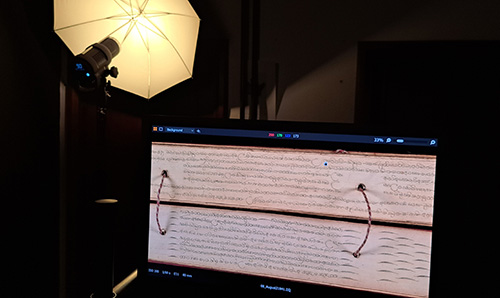Sinhalese Manuscripts
The John Rylands Research Institute and Library, Paramaththa and the International Centre for Theravada Buddhism UK (ICTB UK) have digitised thirty-two Sinhalese Manuscripts and made them freely available online.

Collection
The John Rylands Research Institute and Library holds over seventy manuscripts from Sri Lanka, the majority of which are in the Pali language in Sinhalese script. The collection primarily concerns Theravada Buddhism, but texts cover a range of subjects. The manuscripts date from the 17th-19th centuries and include some unusually complete copies made by Sri Lankan scholars for the scholar T.W. Rhys Davis. Most of the Pali manuscripts are written on palm leaves, but there are also manuscripts written on paper.
Such palm-leaf collections record important Buddhist scripture and early indigenous knowledge of medicine, literature, agriculture, astrology and the arts. They are the primary historical sources that chronicle the linguistic, cultural and technological development of Sri Lanka and its people and are of both anthropological and theological value. The Rylands collection includes a significant number of manuscripts attributed to the Theravada canon and many have been published by the Pali Text Society. There are exceptionally complete manuscripts of the Pattāna Prakārana and Nettipakaraṇa, which are rare even in Sri Lanka.
Copyright © 2022 Sinhalese Palm Leaf Manuscripts Digitisation by International Centre for Theravada Buddhism UK. All Rights Reserved.

The digitisation project
Digitisation of these manuscripts ensures access to primary sources for the Theravada canon, contributing to contemporary theological and historical discourse.
Digital images of the following manuscripts are now freely accessible to anyone in the world through the Library’s Digital Collections platform.
- Abbidhammavatara (Pali MS 10)
- Abhidhammapiṭaka (Pali MS 48)
- Apadanapali (Pali MS 2)
- Dhammapada atthakatha (Pali MS 71)
- Dhammapada atthakatha (Pali MS 9)
- Dhammapada (Pali MS 19)
- Dhatukathappakaranatthakatha and Yamakappakaranaatthakatha (Pali MS 49-50)
- Dighanikaya (Pali MS 15)
- Dipavamsa (Pali MS 64)
- Jātakapāḷi (Pali MS 27)
- Khuddakapāṭha (Pali MS 18)
- Mahaniddesa and Cullaniddesa (Pali MS 53-54)
- Mahāsatipaṭṭhānasutta (Pali MS 65)
- Mahāsatipaṭṭhānasutta (Pali MS 79)
- Manorathapuran (Pali MS 70
- )Manorathapurani (Pali MS 70)
- Nettipakaraṇa (Pali MS 7)
- Paramatthajotika I: (Pali MS 39)
- Paramatthajotikā II (Pali MS 11)
- Paṭisambhidāmagga (Pali MS 28)
- Paṭṭhānappakarana (Pali MS 5)
- Paṭṭhānappakarana (Pali MS 5a)
- Patthanappakaranam (Pali MS 36)
- Petavatthu (Pali MS 24)
- Sasanavamsappadipika (Pali MS 63)
- Sumanigalavilasini (Pali MS 45)
- Suttanipāta (Pali MS 22)
- Theragāthā (Pali MS 25)
- Therīgāthā (Pali MS 26)
- Udānapāli (Pali MS 20)
- Udānapāli (Pali MS 21)
- Vimānavatthu (Pali MS 23)
Our partners
The project has been made possible by generous funding from Paramaththa and the International Centre for Theravada Buddhism UK (ICTB UK).
Paramaththa
Paramaththa is a non-profit organisation based in Sri Lanka that is striving to develop and promote research and theological studies of Theravada Buddhism, positioning its secular and religious discourse within the context of contemporary society. Paramaththa is the platform of a forest monastery in North Central Sri Lanka that was established with the aspiration of sharing the sacerdotal Dhamma knowledge of the most venerable forest monks with the wider society.
International Centre for Theravada Buddhism UK (ICTB UK)
International Centre for Theravada Buddhism UK (ICTB UK) is a UK based non-profit organisation working with Theravada Buddhist monks in the world (specially in Sri Lanka), academics and scholars to provide a tangible communal platform to reinforce the practice of Theravada Buddhism in the UK. A large part of our organisation's mission is to initiate and prosper an effective repository of Theravada Buddhist texts, literature and cultural articles, and make them readily accessible to the public. We believe this will not only be of immense value to the practitioners and devotees of Theravada Buddhism, but also prove extremely beneficial to the broader artistic development of the Buddhist culture.
